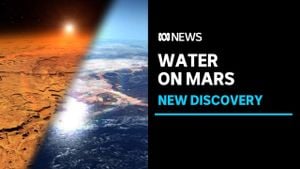Space exploration has always captivated the human imagination, presenting both challenges and opportunities for technological advancements and scientific discovery. Recent findings from various projects have unveiled significant insights, ranging from the mysteries of solar system formation to exciting developments aboard the International Space Station (ISS). These stories highlight the collaborative spirit of scientists, engineers, and students as they push the boundaries of our knowledge.
One exciting discovery emerged from the icy expanse of Antarctica, where researchers have made groundbreaking strides with what has come to be known as "Pine Island amber." This amber contains preserved remnants from 90 million years ago, shedding light on the ancient environmental conditions of West Antarctica. According to Dr. Johann P. Klages, the first author of the study, the analysis of this amber provides direct insights, allowing scientists to reconstruct the forest ecosystem for this region during the mid-Cretaceous period. It reveals how even the polar regions once supported climates suitable for resin-producing trees.
The Pine Island amber study was not only pivotal for its scientific content; it also set the stage for future explorations seeking to understand our planet's climatic history. Through painstaking examinations using microscopic techniques, researchers found details indicating pathological resin flows, likely stemming from damage by parasites or fires. This evidence hints at the existence of rich forest ecosystems near the South Pole long before they transformed under current climatic conditions.
Meanwhile, the contributions of younger generations to space exploration were highlighted during the Kibo Robot Programming Challenge (Kibo-RPC), run by the Japan Aerospace Exploration Agency (JAXA) and the United Nations Office for Outer Space Affairs. With participation from 661 teams from around the globe, students engaged hands-on with real-time programming challenges using robots aboard the ISS. Their goal? Control AstroBee, a free-flying robot tasked with capturing images of the orbital laboratory.
Among the competitors was Team Salcedo, comprised of students from various academic pursuits with unique skill sets. Named after Dr. Alvaro Salcedo, their high school robotics teacher, Team Salcedo members included Aaron Kantsevoy from Georgia Tech, who led the team, and his equally impressive teammates. While they faced challenges like real-time navigation of AstroBee, they found ways to work through obstacles, fostering teamwork and communication skills.
This competition not only emphasized the importance of technical ability but also the mentorship within the field. The students credited NASA staff along with their high school teachers for helping them navigate the challenging project and build their confidence. With their combined efforts, Team Salcedo demonstrated resourcefulness through efficient code testing, showing how collaboration played a key role during the competition.
Perhaps even more exciting than the teamwork aspects were the innovations developed during the event. Various techniques, including Slicing Aided Hyperinference, allowed the teams to tackle their programming tasks creatively. Even when new methods proved too slow to implement during the competition, participants learned valuable lessons about the necessity of efficiency when dealing with time-sensitive engineering challenges.
At the same time, research continued to deepen our comprehension of the solar system's origins. A recent study published in the Astrophysical Journal tackled the longstanding mystery surrounding solar abundances, or the elemental composition of the Sun and its effects on the formation of solar bodies. Dr. Ngoc Truong and his colleagues revealed higher-than-previously assumed levels of carbon, nitrogen, and oxygen existing within the solar system. These findings offer newfound insight pivotal for modeling the characteristics of celestial bodies, including those far beyond our planet, and even suggest links to various forms of exoplanet research.
This multidisciplinary research brought together solar neutrino measurements, data from NASA's Genesis mission, and analysis of meteorites, contributing to our broader quest to understand the primordial solar nebula—the birthplace of our solar system. The results point to dense, rocky characteristics for bodies like Pluto, fueled by tar-like organic compounds long thought to be significant carriers of carbon.
Such revelations have meaningful impacts beyond our solar system. Improved models may influence how astronomers conduct exoplanet research, especially as they aim to comprehend the elemental makeup of planets orbiting distant stars. Dr. Christopher Glein, another contributor to the solar composition study, remarked on the increased potential these findings have for compelling interstellar insights.
Rocket Lab has also been busy facilitating cutting-edge satellite missions, including the upcoming "Ice AIS Baby" launch, which is set to deploy IoT satellites to strengthen global maritime communications. With the technical capabilities of Rocket Lab's Electron rocket, they provide small satellite constellation operators like Kineis the ability to schedule launches and dictate orbits efficiently.
Peter Beck, Rocket Lab's CEO, emphasized the importance of this mission, already the third of five contracted by Kineis to finish deploying its satellite constellation. By ensuring precision and control over launches, they have established themselves as key players for commercial satellite operations, allowing advances like the new dedicated satellite AIS service slated for 2025.
This string of developments surrounding space exploration, from the ancient amber preservation work to the student-led robotics competitions and significant solar composition studies, reflects the collective impact of collaborative efforts. With every mission, experiment, and innovation, our leaders—whether they are seasoned astronauts, researchers, or promising students—continue to inspire our quest for knowledge beyond our planet.
Looking forward, these discoveries and opportunities generate excitement and anticipation for the next breakthroughs. Future missions like the Artemis program seek to ignite the aspirations of the new Artemis Generation—students like those on Team Salcedo who represent the future of space exploration. Echoing the sentiments of NASA's Jorge Sotomayer, these budding innovators may one day be the ones walking on the Moon or Mars, heralding the dawn of new frontiers we have yet to discover. The continuous pursuit of excellence and knowledge is what drives this field, knitting together the educational pathways of scholars and the cutting-edge advancements of scientists across the globe.



